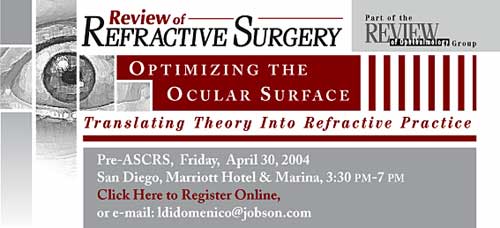BRIEFLY
- INVESTIGATIONAL TREATMENT FOR UVEITIS
SHOWS PROMISE. Researchers at the National Institutes of
Health (NIH) have found in a preliminary trial that an investigational
treatment for uveitis appears to have far fewer side effects than
existing therapies. The trial results, published in the Journal
of Autoimmunity, show that monthly intravenous infusion of a drug
called daclizumab, which has been approved by the FDA for preventing
organ rejection in kidney transplant patients, controlled uveitis
and was well tolerated in seven of 10 patients over four years. The
authors of the study also presented some evidence that a formulation
of daclizumab injected under the skin may provide similar results;
such a formulation might allow uveitis patients to self-administer
the drug. The NIH intends to launch a larger clinical trial to test
standard treatments for uveitis compared with daclizumab.
REFERENCE: Nussenblatt RB, Thompson DJ, Li Z, et al. Humanized anti-interleukin-2 (IL-2) receptor alpha therapy: long-term results in uveitis patients and preliminary safety and activity data for establishing parameters for subcutaneous administration. J Autoimmun 2003;21(3):283-93.
- TUMOR-SUPPRESSOR PROTEIN MAY BE KEY
TO RETINOBLASTOMA TREATMENT. Investigators studying the
tumor-suppressing retinoblastoma protein (Rb) in mice at St. Jude
Children’s Research Hospital in Memphis, TN, may have discovered
how some children develop retinoblastoma, which could in turn lead
to an improved treatment for the disease. Results of the study, which
appeared in Nature Genetics, show that Rb is required for proper
development of the mouse retina; it prompts rod development and limits
the proliferation of immature retinal cells so that the retina develops
normally. The authors of the study believe that they have taken the
first step toward understanding what Rb does during normal mouse development
by using several new genetic techniques to study the mutation in lab
dishes and single retinal progenitor cells rather than in Rb "knockout"
mice, as is commonly the case. Using these methods, the investigators
believe that they can better determine how to block the signals that
trigger retinoblastoma in children.
REFERENCE: Zhang J, Gray J, Wu L, et al. Rb regulates proliferation and rod photoreceptor development in the mouse retina. Nat Genet 2004;Feb 29 [Epub ahead of print].
- NEW STUDY RESULTS PRESENTED FOR EYETECH’S
MACUGEN. Eyetech Pharmaceuticals recently presented additional
data from the VEGF Inhibition Study in Ocular Neovascularization (VISION)
at the Aspen Retinal Detachment Society Meeting in Colorado. Previous
study data on Eyetech’s investigational drug Macugen, a selective
inhibitor of vascular endothelial growth factor (VEGF) in the treatment
of wet age-related macular degeneration (AMD), showed that among the
patients receiving 0.3 mg of Macugen, 70 percent lost less than three
lines of vision on the eye chart, compared with 55 percent of patients
who received sham injection. The new data suggest that the overall
efficacy of Macugen is independent of lesion size and patient age.
Specifically statistical interaction tests indicate that efficacy
is similar in small and large lesions (>4 Disc Areas vs. <4
Disc Areas) as well as in younger and older patients (older than 75
vs. younger than 75). The new data was the result of two pivotal Phase
II/III randomized, multicenter double-masked studies in patients with
all subtypes of wet AMD, in which 1,186 patients were randomized to
receive one of three doses of intravitreous Macugen or a sham (control)
injection every six weeks for 54 weeks. The VISION trial was sponsored
by Eyetech and Pfizer, Inc., which have partnered to develop and market
Macugen.
|





















